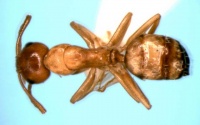Camponotus ogasawarensis
| Camponotus ogasawarensis | |
|---|---|

| |
| Scientific classification | |
| Kingdom: | Animalia |
| Phylum: | Arthropoda |
| Class: | Insecta |
| Order: | Hymenoptera |
| Family: | Formicidae |
| Subfamily: | Formicinae |
| Tribe: | Camponotini |
| Genus: | Camponotus |
| Species: | C. ogasawarensis |
| Binomial name | |
| Camponotus ogasawarensis Terayama & Satoh, 1990 | |
| Common Name | |
|---|---|
| Ogasawara-oo-ari | |
| Language: | Japanese |
This is an arboreal species which nests in dead twigs on trees (Japanese Ant Image Database).
Identification
Keys including this Species
Distribution
Distribution based on Regional Taxon Lists
Palaearctic Region: Japan (type locality).
Distribution based on AntMaps
Distribution based on AntWeb specimens
Check data from AntWeb
Countries Occupied
| Number of countries occupied by this species based on AntWiki Regional Taxon Lists. In general, fewer countries occupied indicates a narrower range, while more countries indicates a more widespread species. |

|
Estimated Abundance
| Relative abundance based on number of AntMaps records per species (this species within the purple bar). Fewer records (to the left) indicates a less abundant/encountered species while more records (to the right) indicates more abundant/encountered species. |

|
Biology
Castes

| |
| . | |
Nomenclature
The following information is derived from Barry Bolton's Online Catalogue of the Ants of the World.
- ogasawarensis. Camponotus (Myrmamblys) ogasawarensis Terayama & Satoh, 1990c: 117, figs. 1-26 (s.w.q.m.) JAPAN.
- Type-material: holotype minor worker, 15 paratype major workers, 28 paratype minor workers, 4 paratype queens, 7 paratype males.
- Type-locality: Japan: Ogasawara Is., Ani-jima I., Kanaimisaki, 31.iii.1990 (K. Tomiyama); paratypes: 5 major workers, 15 minor workers, 2 queens, 3 males with same data, 2 minor workers, 4 males with same data but 4.vii.1989, 1 minor worker, 2 queens with same data but 21.vii.1990, 9 major workers, 11 minor workers with same data but 5.iii.1986 (T. Satoh); the authors also give an additional long series of minor collections, all paratypes.
- Type-depositories: NIAS (holotype); NHMB, NIAS, NSMT, OMNH (paratypes).
- Status as species: Morisita, et al. 1991: 43; Bolton, 1995b: 115; Radchenko, 1997d: 813; Terayama, 1999b: 28 (in key); Imai, et al. 2003: 35; McArthur, 2012: 118.
- Distribution: Japan.
Description
References
- Imai, H.T., Kihara, A., Kondoh, M., Kubota, M., Kuribayashi, S., Ogata, K., Onoyama, K., Taylor, R.W., Terayama, M., Yoshimura, M., Ugawa, Y. 2003. Ants of Japan. 224 pp, Gakken, Japan.
- Terayama, M.; Satoh, T. 1990c. Camponotus (Myrmamblys) ogasawarensis sp. nov. from the Ogasawara Islands, Japan (Insecta, Hymenoptera, Formicidae). Bull. Biogeogr. Soc. Jpn. 45: 117-121 (page 117, figs. 1-26 soldier, worker, queen, male described)
References based on Global Ant Biodiversity Informatics
- Terayama M. 1992. Structure of ant communities in East Asia. A. Regional differences and species richness. Bulletin of the Bio-geographical Society of Japan 47: 1-31.
- Terayama M. and E. Hasegawa. 1991. Ant fauna of the Ogasawara islands. OgasawaraKenkyuNenpo 15: 4051.
- Terayama M., S. Kubota, and K. Eguchi. 2014. Encyclopedia of Japanese ants. Asakura Shoten: Tokyo, 278 pp.
- Terayama M., and S. Kubota. 2002. Ants of Tokyo, Japan. ARI 26: 1-32.
- Terayama M.; Satoh, T. 1990. Camponotus (Myrmamblys) ogasawarensis sp. nov. from the Ogasawara Islands, Japan (Insecta, Hymenoptera, Formicidae). Bulletin of the Biogeographical Society of Japan 45:117-121.

